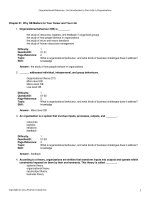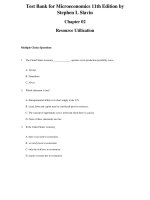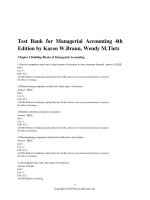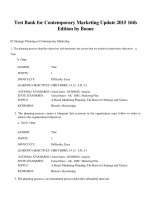Link full download test bank for organizational behaviour an introduction to your life in organizations first canadian edition 1st edition by andre
Bạn đang xem bản rút gọn của tài liệu. Xem và tải ngay bản đầy đủ của tài liệu tại đây (407.87 KB, 52 trang )
Test Bank For Organizational Behaviour An Introduction to Your Life
in Organizations First Canadian Edition 1st Edition by Andre
Chapter 01: Why OB Matters for Your Career and Your Life
1. Organizational behaviour (OB) is ________.
the study of resources, logistics, and feedback in organized groups
the study of how people behave in organizations
the study
of micro and macro iterations the study of human resources
management
Difficulty:
QuestionID:
Page-Reference:
Topic:
Skill:
1
01-01
2
What is organizational behaviour, and what kinds of business challenges does it address?
knowledge
Answer: the study of how people behave in organizations
2. _______ addresses individual, interpersonal, and group behaviours.
Organizational theory (OT)
Micro level OB
Macro level OB
Low-level OB
Difficulty:
QuestionID:
Page-Reference:
Topic:
Skill:
1
01-02
2
What is organizational behaviour, and what kinds of business challenges does it address?
knowledge
Answer: Micro level OB
3. An organization is a system that involves inputs, processes, outputs, and ________.
resources
logistics
iterations
feedback 1
01-03
1
Difficulty:
QuestionID:
Page-Reference:
Topic:
Skill:
4
What is organizational behaviour, and what kinds of business challenges does it address?
knowledge
Answer: feedback
4. According to a theory, organizations are entities that transform inputs into outputs and operate within
constraints imposed on them by their environments. This theory is called ________.
systems theory
organizational theory
input/output theory
business theory
Difficulty:
QuestionID:
Topic:
Skill:
2
01-04 Page-Reference: 4
What is organizational behaviour, and what kinds of business challenges does it address?
knowledge
Answer: systems theory
5. Feedback includes information about a company's outputs such as how the outputs have been
________.
perceived by customers
developed by personnel
brought to market
improved
Difficulty:
QuestionID:
Topic:
Skill:
1
01-05 Page-Reference: 4
What is organizational behaviour, and what kinds of business challenges does it address?
knowledge
Answer: perceived by customers
6.
An organization that has permeable boundaries permits the free flow of information both into and out of
the organization. The best example of an organization with permeable boundaries is one that ________.
restricts internet access
communicates within teams but not between teams
encourages workers to visit and learn from their customers
has an innovative development team that keeps proprietary information secret
2
Difficulty:
QuestionID:
Topic:
Skill:
3
01-06 Page-Reference: 4
What is organizational behaviour, and what kinds of business challenges does it address?
knowledge
Answer: encourages workers to visit and learn from their customers
7.
A system is a set of elements that combine to form a complex whole.
a
True b
False
Difficulty:
1
QuestionID:
01-07
Page-Reference: 3
Topic:
What is organizational behaviour, and what kinds of business challenges does it address?
Skill:
knowledge
Answer: a. True
8.
Universities take in students (inputs) and turn them into educated citizens (outputs).
a
True b
False
Difficulty:
2
QuestionID:
01-08
Page-Reference: 4
Topic:
What is organizational behaviour, and what kinds of business challenges does it address?
Skill:
comprehension
Answer: a. True
9.
Organizations that have impermeable boundaries and do not easily absorb inputs from their
environments are called open systems.
3
Difficulty:
QuestionID:
Page-Reference:
Topic:
Skill:
a
True b
False
Difficulty:
2
QuestionID:
01-09
Page-Reference: 4
Topic:
What is organizational behaviour, and what kinds of business challenges does it address?
Skill:
knowledge
Answer: b. False
10. Closed systems are more likely than open systems to adapt to environmental changes.
a
b
True
False
Difficulty:
2
QuestionID:
01-10
Page-Reference: 4
Topic:
What is organizational behaviour, and what kinds of business challenges does it address?
Skill:
knowledge
Answer: b. False
11. In a short essay, explain what organizational behaviour is.
4
Difficulty:
QuestionID:
Page-Reference:
Topic:
Skill:
Answer:
1
01-11
2
What is organizational behaviour, and what kinds of business challenges does it address?
comprehension
Organizational behaviour (OB), simply put, is the study of how people behave in organizations.
Organizational behaviour is a social science. This means that, by definition, its findings are based on data
obtained through systematic study. People who study and apply OB aim to enhance worker well-being and
organizational effectiveness by applying psychological and human systems knowledge. In addition to its own
research, OB incorporates concepts and research from other social sciences, including psychology, political
science, economics, communication, sociology, and anthropology.
12. In a short essay, apply systems theory to organizations and discuss organizations in light of being
open or closed systems.
Difficulty:
QuestionID:
Page-Reference:
Topic:
Skill:
3
01-12
4
What is organizational behaviour, and what kinds of business challenges does it address?
knowledge
Answer: According to systems theory, organizations are entities that transform inputs into outputs and
operate within constraints imposed on them by their environments. Visualizing your organization as a system
helps you see its basic elements clearly. The elements of the system are its inputs, processes, outputs, and
feedback. Inputs to a company include materials, ideas, and employees.
Organizations that easily absorb inputs from their environments are called open systems. They have
permeable boundaries that permit the free flow of information both into and out of the organization. An
example of an open system is a company that does everything it can to make sure its employees understand
customer needs, encouraging workers at all levels to visit with and learn from their customers.
Closed systems refer to organizations that do not absorb inputs so easily because they have impermeable
boundaries that restrict information flow. An example of a closed system is a company that only allows
salespeople, rather than employees from other functions, to meet customers.
Because open systems can learn, they are more likely than closed systems to adapt to environmental
changes. Most modern organizations strive to be open systems. Only the rare company, usually a monopoly,
is so powerful that it can afford to be a closed system that ignores its environment.
13. The modern phenomenon of the increased internationalization of business is called ________.
5
Difficulty:
QuestionID:
Page-Reference:
Topic:
Skill:
Answer:
internationalization
globalization
manifest destiny
marketization
Difficulty:
QuestionID:
Page-Reference:
Topic:
Skill:
1
01-13
5
What economic and social issues challenge today's organizations?
knowledge
Answer: globalization
14. Globalization is the movement of trade, resources, and ________ across borders and regions.
supplies
equipment
personnel
inputs
Difficulty:
QuestionID:
Page-Reference:
Topic:
Skill:
1
01-14
5
What economic and social issues challenge today's organizations?
knowledge
Answer: personnel
15. In the future in Canada, most newly created jobs will be in ________ companies.
foreign
domestic
large and existing
small
6
Difficulty:
QuestionID:
Page-Reference:
Topic:
Skill:
2
01-15
5
What economic and social issues challenge today's organizations?
knowledge
Answer: small
16. Research suggests that most company founders got their business ideas through work experience in
their prior jobs. Founders' new businesses were most likely to be successful if they developed crucial
contacts with customers, suppliers, and ________.
potential employees
competitors
international business leaders
domestic business leaders
Difficulty:
QuestionID:
Page-Reference:
Topic:
Skill:
2
01-16
5
What economic and social issues challenge today's organizations?
knowledge
Answer: potential employees
17. Which type of occupations will grow the most in Canada in the near future?
housing; transportation education;
health
computer technology; internet commerce
food production; power generation
2
01-17
6
What economic and social issues challenge today's organizations?
knowledge
education; health
18. In recent decades, the average pay for workers in rich countries, including Canada, has stagnated or
even fallen. A possible reason for this is that ________.
government regulations put a cap on salaries
competition for employees has kept wages low jobs
are being outsourced
illegal immigrants are performing entry-level jobs
7
Difficulty:
QuestionID:
Page-Reference:
Topic:
Skill:
Answer:
Difficulty:
QuestionID:
Page-Reference:
Topic:
Skill:
3
01-18
6
What economic and social issues challenge today's organizations?
knowledge
Answer: jobs are being outsourced
19. In the face of competitive pressures, some companies go out of business while others _______.
downsize or rightsize
create a small number of contingent positions
send employees to work in their offshore operations
increase their workforce to increase productivity
Difficulty:
QuestionID:
Page-Reference:
Topic:
Skill:
3
01-19
6
What economic and social issues challenge today's organizations?
knowledge
Answer: downsize or rightsize
20. In 2003, Kodak predicted that the film industry would decline by about 10 percent a year. Instead, it
declined by closer to 30 percent. What could account for this difference?
Kodak failed to anticipate changes in technology.
Kodak made decisions to downsize.
Kodak's competition in the film industry increased.
Kodak anticipated changes in the film industry.
Difficulty:
QuestionID:
Page-Reference:
Topic:
Skill:
2
01-20
6
What economic and social issues challenge today's organizations?
application
8
Answer: Kodak failed to anticipate changes in technology.
21. Productivity increases in the manufacturing industry have reduced the need for workers. What factor
best accounts for this increase in productivity?
Better workforce training Information technology
innovation
Faster work pace
Increase in the number of managers
Difficulty:
QuestionID:
Page-Reference:
Topic:
Skill:
2
01-21
6
What economic and social issues challenge today's organizations?
knowledge
Answer: Information technology innovation
22. _____ are jobs that are temporary and not expected to last.
Casual temp jobs
Information technology innovation jobs
Entry-level management jobs
Contingent jobs
Difficulty:
QuestionID:
Page-Reference:
Topic:
Skill:
2
01-22
7
What economic and social issues challenge today's organizations?
knowledge
Answer: Contingent jobs
23. A few developed countries, including Japan and Germany, are expected to suffer workforce
shrinkages by 2030. Which of the following could be a cause of this shrinkage?
An aging workforce
A stall in developing new technological advances
An increase in the number of marriages
Lower life expectancies
Difficulty:
QuestionID:
Page-Reference:
Topic:
Skill:
1
01-23
7
What economic and social issues challenge today's organizations?
knowledge
Answer: An aging workforce
24. Companies are competing to hire individuals of _______, the largest demographic cohort since the
boomers.
baby
9
Difficulty:
QuestionID:
Page-Reference:
Topic:
Skill:
Answer:
Generation Y
the Millennial generation
the pre-baby boomer generation
the me-first generation
2
01-24
8
What economic and social issues challenge today's organizations? knowledge
the Millennial generation
25. ________ are the skills, attitudes, and behaviours that you need to enter, and to continue to participate
and progress in, today's dynamic world of work.
Interpersonal proficiencies
Personal attributes
Creative ethics
Employability skills
Difficulty:
QuestionID:
Page-Reference:
Topic:
Skill:
1
01-25
9
What economic and social issues challenge today's organizations?
knowledge
Answer: Employability skills
26. Which of the following skills do employers rank most important overall?
Writing
Speaking/listening
Computer competency
Planning/time management
Difficulty:
2
QuestionID:
01-26
Page-Reference: 9
10
Topic:
Skill:
What economic and social issues challenge today's organizations?
knowledge
Answer: Speaking/listening
27. Among occupational groups in Canada, which types of workers are most unionized?
Police, justice workers, and social workers
Mining, oil, and resource development
Accounting, middle management, and independent business
Public administration, education, and health care
Difficulty:
QuestionID:
Page-Reference:
Topic:
Skill:
3
01-27
9
What economic and social issues challenge today's organizations?
knowledge
Answer: Public administration, education, and health care
28. Members of the Millennial generation will have excellent opportunities in the workforce provided they
have a sound education and they ________.
are willing to relocate wherever the jobs are
are willing to work
for the same company for more than five years
have connections
in the industry they're interested in have experience with international
companies
Difficulty:
QuestionID:
Page-Reference:
Topic:
Skill:
2
01-28
10
What economic and social issues challenge today's organizations?
knowledge
Answer: are willing to relocate wherever the jobs are
29. One reason for downsizing is that using cheaper labour abroad saves the company money.
a
b
True
False
Difficulty:
1
QuestionID:
01-29
Page-Reference: 6
Topic:
What economic and social issues challenge today's organizations?
Skill:
knowledge
11
Difficulty:
QuestionID:
Page-Reference:
Topic:
Skill:
Answer:
Answer: a. True
30. Contingent jobs are desirable because they are secure and not open to downsizing.
a
b
True
False
Difficulty:
2
QuestionID:
01-30
Page-Reference: 7
Topic:
What economic and social issues challenge today's organizations?
Skill:
knowledge
Answer: b. False
31. Discuss globalization and how it changes the nature of work.
Difficulty:
QuestionID:
Page-Reference:
Topic:
Skill:
2
01-31
5
What economic and social issues challenge today's organizations?
knowledge
12
Answer: Globalization is the internationalization of business—the movement of trade, resources, and
personnel across borders and regions. Many people hoped that globalization would benefit both advanced
industrial countries and the developing world. Some argue cogently that it has. But others raise concerns.
Today companies and jobs are influenced by globalization as never before. Many companies no longer
selfidentify with their home country, but consider themselves international. And although many North
American workers continue to have good jobs, others have to compete against workers internationally both to
obtain work and to earn a living wage.
Global competition affects the nature of the work that companies offer. For instance, it affects whether
products are both designed and manufactured in Canada. It also affects where jobs are located. For example,
a pharmaceutical firm may do its genetic research in Mississauga, Ontario, but produce its drugs in the
Caribbean. Finally, globalization affects how companies manage people, including how they design their
organizational structures and cultures and how they manage and motivate their employees.
32. Explain what is meant by employability skills and provide some examples of skills that are important
in today's working world.
Difficulty:
QuestionID:
Page-Reference:
Topic:
Skill:
2
01-32
9
What economic and social issues challenge today's organizations?
knowledge
Answer: Employability skills are the skills, attitudes, and behaviours needed to enter, and continue to
participate and progress in, today's dynamic world of work. These include the fundamental skills of
communication, numeracy, information management, analytical thinking, and problem solving, plus personal
management skills and team-work skills. Personal management skills include positive attitudes and
behaviours, such as honesty and integrity, initiative, persistence, responsibility, and accountability.
33. Discuss implications of globalization trends on the jobs of Canadian workers.
Difficulty:
QuestionID:
Page-Reference:
Topic:
Skill:
2
01-33
10
What economic and social issues challenge today's organizations?
knowledge
Answer: Globalization, the changing nature of work, and the complex workforce will all affect your life in
organizations. Although a minority of workers and business owners may be unaffected by today's global
business environment, during your career you likely will be.
You may also face the effects of job growth and disruption as they affect Canadian workers and, indeed,
workers in all developed countries. Certainly you will see organizations change and evolve culturally and
structurally as they respond to global competition.
If you are a member of the Millennial generation, you will have excellent opportunities to find a good job in a
good company, provided that you have a sound education and are willing to relocate to wherever the jobs
are. You can expect companies to work hard to keep you, too. As many as a third of new employees leave
within three years, and it costs a company nearly $10 000 per person to train replacements.
13
Finally, as a result of its ethnic, cultural, and other diverse aspects, the Canadian workforce tends to be
dynamic and creative and also, at times, challenging. You may find that managing a diverse workforce, and
being a member of the diverse workforce yourself, are, and continue to be, a challenge for the foreseeable
future.
34. Companies work hard to encourage innovation and high-quality decision making as a result of having
to deal with fast-paced international competition. To compete, companies are doing all but which of the
following?
Relying extensively on teams
Giving high-tech employees limited work contracts
Changing the way they attract and keep trained workers
Making important adaptations in their organizational designs
Difficulty:
QuestionID:
Page-Reference:
Topic:
Skill:
2
01-34
10
What organizational processes help companies compete in the modern economy?
knowledge
Answer: Relying extensively on teams
35. Work that requires high levels of analysis and is performed by well-educated individuals is called
________ work.
manufacturing
innovative
knowledge
technical
Difficulty:
QuestionID:
Page-Reference:
Topic:
Skill:
1
01-35
10
What organizational processes help companies compete in the modern economy?
knowledge
Answer: knowledge
36. Companies use effective teams in their quest to be competitive. What is one reason companies use
Teams require more guidance than individuals.
Teams can replace expensive managers.
Teams make the work routine.
Members of the baby boomer generation are comfortable working in teams.
Difficulty:
QuestionID:
Page-Reference:
Topic:
Skill:
teams?
2
01-36
10
What organizational processes help companies compete in the modern economy?
knowledge
14
Answer: Teams can replace expensive managers.
37. Some companies hope to attract and keep effective employees by catering to their preferences. Which
of the following may they offer to accomplish this goal?
A focus on employee work rather than peripheral social causes
Decreasing employee training time
Enhancing employee work-life balance
Longer work weeks to maximize employee earnings
Difficulty:
QuestionID:
Page-Reference:
Topic:
Skill:
2
01-37
10
What organizational processes help companies compete in the modern economy?
knowledge
Answer: Enhancing employee work-life balance
38. A boundaryless organization is one in which ________.
external barriers to communication and information are removed
growth is uncontrolled growth is carefully controlled
internal barriers to communication and information are removed
Difficulty:
QuestionID:
Page-Reference:
Topic:
Skill:
2
01-38
11
What organizational processes help companies compete in the modern economy?
knowledge
Answer: external barriers to communication and information are removed
39. Companies today strive to be lean. The most effective way they accomplish this is by ________.
laying off trained workers
operating with the least costly payroll
hiring new college graduates
keeping a ceiling on their growth
Difficulty:
QuestionID:
Page-Reference:
Topic:
Skill:
2
01-39
11
What organizational processes help companies compete in the modern economy?
knowledge
Answer: operating with the least costly payroll
40. Companies are adapting their macro level processes by becoming less ________ and more ________.
15
management top heavy; creative
farsighted; nearsighted bureaucratic;
enterprising
competitive;
cooperative
Difficulty:
QuestionID:
Page-Reference:
Topic:
Skill:
2
01-40
11
What organizational processes help companies compete in the modern economy?
knowledge
Answer: bureaucratic; enterprising
41. The ability of employees to make decisions that traditionally were made by managers alone is called
employee ________.
creativity
empowerment
rights
responsibilities
Difficulty:
QuestionID:
Page-Reference:
Topic:
Skill:
1
01-41
11
What organizational processes help companies compete in the modern economy?
knowledge
Answer: empowerment
42. Some companies make system-wide process improvements by focusing on enhancing quality in their
________.
core competency operations
quality assurance departments
business management levels
financial services departments
Difficulty:
QuestionID:
Page-Reference:
Topic:
Skill:
3
01-42
11
What organizational processes help companies compete in the modern economy?
knowledge
Answer: core competency operations
43. Organization-wide processes that emphasize excellence in outcomes such as product reliability and
durability are called ________ systems. quality assurance
total quality management
streamlined process
organizational learning Difficulty:
2
QuestionID:
01-43
16
Page-Reference: 11
Topic:
What organizational processes help companies compete in the modern economy?
Skill:
knowledge
Answer: total quality management
44. Re-engineering is the redesign of business processes to improve performance on outcomes such as
________.
revenue, implementation, feedback, and follow-up
service, delivery, contact, and analysis quality,
quantity, analysis, and reporting
cost, quality,
service, and speed
Difficulty:
QuestionID:
2
01-44 Page-Reference:
11
Topic:
Skill:
What organizational processes help companies compete in the modern economy?
knowledge
Answer: cost, quality, service, and speed
45. Companies want to keep and protect processes that give them competitive advantage. The process by
which knowledge that is acquired by individuals is embedded in organizational memory is known as
________.
total quality management streamlined
processes
organizational
learning memory acquisition
Difficulty:
QuestionID:
3
01-45 Page-Reference:
11
Topic:
Skill:
What organizational processes help companies compete in the modern economy?
knowledge
Answer: organizational learning
46. Scenario: Teamwork and Organizational Design
Paul is part of a team that is designing a new car for a major automobile manufacturer. He has met
with engineers, safety coordinators, and consumer test groups over the past six months.
Because Paul has worked with engineers and safety managers, he has become familiar with
knowledge work, which is defined as ________.
work that is performed by people who use computer technology work requiring high
levels of analysis that is performed by well-educated individuals
work that is
performed by Paul after visiting with a variety of professionals
work that is
performed primarily by research and development departments
17
3
01-46
10
What organizational processes help companies compete in the modern economy?
application
work requiring high levels of analysis that is performed by well-educated individuals
47. Scenario: Teamwork and Organizational Design
Paul is part of a team that is designing a new car for a major automobile manufacturer. He has met
with engineers, safety coordinators, and consumer test groups over the past six months.
Paul's team has several engineers who work four ten-hour days per week, so they can take Fridays
off. The reason for this flexible work schedule is that their homes are three hours away, so they live
out of a hotel during the week. What is this schedule an example of?
A policy to make sure all important work is done before Friday
A policy to make sure engineers are not overworked
A policy to make sure engineers earn their high salaries
A policy to enhance the work-life balance of the employees
Difficulty:
QuestionID:
2
01-47 Page-Reference:
10
Topic:
Skill:
What organizational processes help companies compete in the modern economy?
application
Answer: A policy to enhance the work-life balance of the employees
48. Scenario: Teamwork and Organizational Design
Paul is part of a team that is designing a new car for a major automobile manufacturer. He has met
with engineers, safety coordinators, and consumer test groups over the past six months.
Paul's organization is thinking about becoming boundaryless, which means ________.
all employees at all levels are encouraged to think of the customers
all
employees are encouraged to share office supplies with coworkers only employees
at the executive level should think of the customers only employees with five or more
years of experience should address customers
Difficulty:
QuestionID:
2
01-48 Page-Reference:
10
Topic:
Skill:
What organizational processes help companies compete in the modern economy?
application
Answer: all employees at all levels are encouraged to think of the customers
49. Scenario: Teamwork and Organizational Design
18
Difficulty:
QuestionID:
Page-Reference:
Topic:
Skill:
Answer:
Paul is part of a team that is designing a new car for a major automobile manufacturer. He has met
with engineers, safety coordinators, and consumer test groups over the past six months.
Paul's organization is serious about its ethical practices and makes sure stakeholders, stockholders,
and governments can see company decision making and assess its truthfulness. This is termed
________.
a networked organization
transparency outside
knowledge organizational
learning
Difficulty:
QuestionID:
3
01-49 Page-Reference:
10
Topic:
Skill:
What organizational processes help companies compete in the modern economy?
application
Answer: transparency
50. Knowledge work usually requires the integration of the ideas of a variety of specialists.
a
b
True
False
Difficulty:
2
QuestionID:
01-50
Page-Reference: 10
Topic:
What organizational processes help companies compete in the modern economy?
Skill:
knowledge
Answer: a. True
51. Managers are paying increased attention to organizational ethics because organizations that do pay
attention perform better financially.
a
True
b
False
Difficulty:
2
19
QuestionID:
01-51
Page-Reference: 12
Topic:
What organizational processes help companies compete in the modern economy?
Skill:
knowledge
Answer: a. True
52. Discuss innovations used by companies to attract and keep employees and provide examples of the
innovations.
3
01-52
10-11
What organizational processes help companies compete in the modern economy?
comprehension
Companies that hope to attract and keep their employees cater to their preferences. For example,
they may offer their employees opportunities to increase their training, enhance their work-life balance, and
even advance social causes.
To illustrate, Millennials (along with other generations) want to balance their work and family lives. In a survey
of 37 000 undergraduates, this was their number-one career goal. As a result, more and more companies
now offer flexible work schedules. In fact, the results of a recent study suggest that 88 percent of Canadian
businesses are now offering their employees some kind of flexible work arrangements. Companies also want
to retain their talented young women after they become mothers. The consulting firm Booz Allen Hamilton
strives to achieve this by creating meaningful internal jobs for its young female consultants who want to
reduce their travel time. Members of the Millennial generation also want on-the-job training, and top
employers are responding with extensive training programs. Student internships are popular, too. Students
learn a lot from them, and, increasingly, companies rely on them to recruit permanent employees.
Millennials are also highly interested in companies that show social responsibility. To meet this interest, one
investment firm raised its standard company match for employee charitable contributions from $2000 to $10
000!
53. In a recent study of recruiters at 85 business schools, recruiters ranked ______ as most important.
problem-solving skills
communication and interpersonal skills
leadership skills
technological
skills
Difficulty:
QuestionID:
1
01-53 Page-Reference:
13
Topic:
Skill:
What will your career be like in modern organizations?
knowledge
20
Difficulty:
QuestionID:
Page-Reference:
Topic:
Skill:
Answer:
Answer: communication and interpersonal skills
54. The ________ includes professional, managerial, and other white-collar jobs.
primary labour market
transitory career option
desired end-state
secondary labour market
Difficulty:
QuestionID:
1
01-54 Page-Reference:
14
Topic:
Skill:
What will your career be like in modern organizations?
knowledge
Answer: primary labour market
55. A ________ career is characterized by a lifetime of employment in one job.
linear
transitory
steady state
spiral
Difficulty:
QuestionID:
2
01-55 Page-Reference:
14
Topic:
Skill:
What will your career be like in modern organizations?
knowledge
Answer: steady state
56. Bev has a keen interest in technology. Over the past two decades, she has moved from job to job, but
always worked on some aspect of technology that interested her at the time. Bev has had a ______
career.
linear
transitory
steady state
spiral
21
Difficulty:
QuestionID:
2
01-56 Page-Reference:
14
Topic:
Skill:
What will your career be like in modern organizations?
comprehension
Answer: spiral
57. Chen likes to change jobs frequently. His interests are so varied that he has worked in several
unrelated fields such as accountant, recording artist, and school crossing guard. Chen has enjoyed a
______ career.
linear
transitory
steady state
spiral
Difficulty:
2
QuestionID:
01-57
Page-Reference: 14
Topic:
What will your career be like in modern organizations?
Skill:
comprehension
Answer: transitory
58. A person's occupational self-concept, based on one's self-perceived talents, abilities, values, needs,
and motives, is called a career ________.
self-concept
trajectory
anchor
path
2
01-58
14
What will your career be like in modern organizations?
knowledge
anchor
59. Independent contributors are people who work without subordinates to do an important organizational
job. The best example of an independent contributor is a(n) ________.
dentist
office manager market
researcher newspaper
editor
Difficulty:
2
22
Difficulty:
QuestionID:
Page-Reference:
Topic:
Skill:
Answer:
QuestionID:
01-59 Page-Reference:
16
Topic:
Skill:
What will your career be like in modern organizations?
knowledge
Answer: market researcher
60. Scenario: Understanding How Careers Work
Christa works at a fast-paced medical sales firm, which is constantly looking for ways to improve
business.
Because Christa is new to the company, she often turns to Barb for mentoring. Barb is someone who
can work with anyone and get the desired results for a project in record time. Barb is someone who
________.
has cultivated her organizational behaviour skills to achieve success
has become a candidate for the new management fast-track program
has wormed her way up the corporate ladder by being two-faced
has developed office cliques to establish herself as a leader
Difficulty:
QuestionID:
2
01-60 Page-Reference:
13
Topic:
Skill:
What will your career be like in modern organizations?
application
Answer: has cultivated her organizational behaviour skills to achieve success
61. Scenario: Understanding How Careers Work
Christa works at a fast-paced medical sales firm, which is constantly looking for ways to improve
business.
Christa is currently in beginning sales, but would like to work at a different company as a sales
executive. She will most likely have ________.
a steady state career
a spiral career a
linear career
an obligatory career
Difficulty:
QuestionID:
3
01-61 Page-Reference:
14
Topic:
What will your career be like in modern organizations?
23
Skill:
application
Answer: a linear career
62. Scenario: Understanding How Careers Work
Christa works at a fast-paced medical sales firm, which is constantly looking for ways to improve
business.
Barb works with Christa and is viewed as a leader by her peers. Barb is seen as a solid contributor,
but her career has reached a plateau and she is not in line for advancement. Barb is in which career
stage?
Stage 1—preparation
Stage 2—organizational entry
Stage 3—early career
Stage 4—middle career
Difficulty:
QuestionID:
3
01-62 Page-Reference:
15
Topic:
Skill:
What will your career be like in modern organizations?
application
Answer: Stage 4—middle career
63. Linear careers are often called boundaryless careers.
a
b
True
False
Difficulty:
2
QuestionID:
01-63
Page-Reference: 14
Topic:
What will your career be like in modern organizations?
Skill:
knowledge
Answer: a. True
64. Dawn has an interest in fast food. She started making sandwiches at the crew level, moved up to
manage her own restaurant, and now is in line to become the president of the company. Dawn has
followed a linear career path.
a
True
b
False
Difficulty:
3
24
Difficulty:
QuestionID:
Page-Reference:
Topic:
Skill:
Answer:
QuestionID:
01-64
Page-Reference: 14
Topic:
What will your career be like in modern organizations?
Skill:
application
Answer: a. True
25









